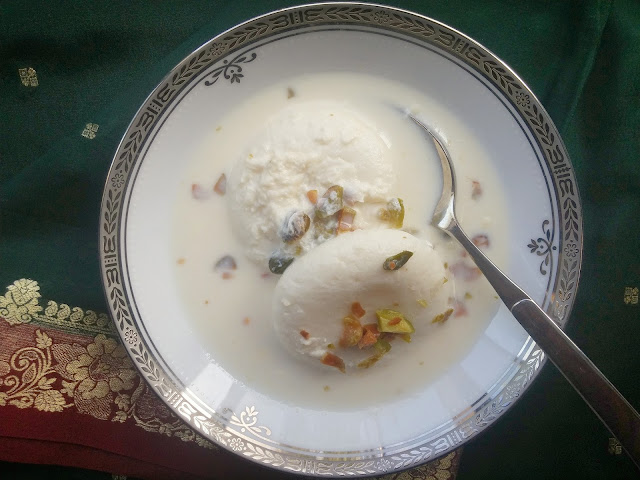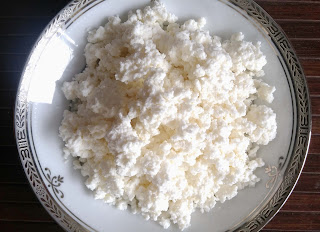Rasmalai is one of the most popular Indian dessert made with Chhena (Indian cottage cheese). The soft texture of the tender cheese balls combined with the creamy condensed milk, gives it a unique taste which is much appreciated among the Indian sweet lovers.
Coming from eastern part of India I always have a weakness for sweets made with Chhena. But those sweets aren't always available because of their perishable nature. And the ones we get now a days are sold frozen, which kind of deters the original taste. I started trying this recipe on my own years back... thanks to my friend Chandra's inspirations :) It took me a while and many failed attempts to successfully make it. But once I got a hang of the recipe, it was really simple to make. And the homemade ones are always worth the work since you know what exactly goes into it.
Making Rasmalai is a two step process, first making the cheese dumpling or Rasgullas, and then adding it to the Malai that is the condensed milk base for the sweet. First I'll go through the details of preparing the soft paneer/ chhena for making the rasgullas, which I'm copying from my previous post:)
Making Soft Paneer/ Chhena
Chhena is the basic curd-cheese used in many different Indian recipes. Paneer is a slightly overcooked and pressed form of Chhena. Chhena is made by adding an acid to boiling hot milk, to separate the milk-solids from the whey. Then the curdled milk-solid(Chhena) is drained and collected for cooking usage. The remaining whey can also be used as the acid to make the next batch of Chhena, as well as in various other preparations. To make hard Paneer the Chhena has to be kneaded and pressed tightly, while still hot. But to make soft Paneer the Chhena has to be blanched in ice-cold water immediately then drained.
Milk: Traditionally Cow’s milk or Water Buffalo’s milk is used to make Chhena. Since cow's milk is conveniently available, it is usually used to make Chhena at home. I prefer to use full fat milk, but 2% milk can also be used. But fat-free milk yields less amount of Chhena and it's also isn't as soft. And it also helps if the Milk is in room temperature.
Acid: Many kind of acidic elements can be used, but Key-lime seems to the best among them. few others are lemon, plain vinegar, citric-acid, curd, whey...etc.
The amount for acid per liter (Gallon is approximately 2 liters) of milk is
1 to 2 tbsp. Lime or Lemon juice (mixed with a cup of water)
1 to 2 tbsp. Vinegar (mixed with a cup of water)
1 cup yogurt 1/2 tsp Citric Acid (mixed with a cup of water)
2 cups Whey
More acid should be added if the milk doesn't separate. Saucepan: I prefer to use an aluminum pan.
Put Put room temperature milk in a saucepan then put it on a medium high heat. Let it come to a boil, stirring occasionally so that it doesn't stick to the bottom. it should take about 20 minutes for a gallon of milk. At first it'll foam up(pic1) but wait till it gets to a continuous boil(pic3). let it simmer for 5 more minutes. Then switch off the heat.
Wait for 2 more minutes, then start stirring the milk in a circular motion. Gradually add the acid while still stirring. The milk will start to cuddle and separate from the whey. if the whey still seems to be cloudy then add some more acid, till it seems clear (pic7). Let it rest for a minute.
Arrange the Cheese cloth on a colander and pour the curdles milk to strain. Keep a pot under the colander if you want to collect and use the whey. Then start pouring cold water immediately(pic9). Wash the Chhena thoroughly making sure it's cold allover.
Gather the corners of the cheesecloth and bind it squeezing the extra water out of the Chhena. Then wrap it with a towel to soak up the extra moisture. For making Rasgulla you'll need to press it for 5 to 10 minutes with a heavy weight(pic12), making sure there is no extra moisture. Don't drain it for too long.
This is the soft Chhena(pic14). But for using it in sweet preparations you've to mash it with light hand. That will get rid of any lumps and will make it's consistency uniform.
The kneading has to be with the palm with soft storks. And you'll basically be stretching it with your palm. The Chhena usually is firm at first because it's been blanched in ice-cold water. But after a few minutes of kneading it gets softer and comes together perfectly.
Once it is softer you'll be able to knead it with your fingers. Knead it few more times, then all of it will come together. It'll take about 15 minutes of kneading.
Making the Rasgullas
Chhena (Soft Paneer) 1cup
Sugar 3cups, and a teaspoon
Water 5 cups, and 1 more cup
Cardamom powder 1tsp
Knead the chhena till it is smooth and out of any granulate. Then add the cardamom powder and a teaspoon of sugar. In this stage if it seems like the chhena is too watery then add a tablespoon of semolina. Mine looks like a good consistency, so I’ll skip adding the semolina. Mix it for a few more minutes till everything is well incorporated.
Then take out small equal size proportions of the dough and shape it into a smooth ball using both of your palm. Then Flatten them with a little pressure to shape it like a disk. Set aside the shaped chhena balls, covering it with a wet cheesecloth or kitchen towel.
Heat 5 cups of water with 3 cups of sugar in a flat bottom pot or saucepan over medium heat. Cook it till all the sugar dissolves and let it simmer for a few more minutes. Then add the cheena balls gently, one at a time. Add a few balls at one batch, making sure not to over crowd the pot, since the balls will increase more than double in volume.
Let the balls simmer for a few minutes then try turning them over with a silicon spatula, making sure not to poke or tear them. Then cover it with a lid and let it cook for about 8 to 10 minutes. If you have made smaller size balls then they’ll cook faster, so cook it for 5 to 7 minutes instead. Switch off the heat and remove the cover. Let it cool down completely, then drain out the sugar syrup from the rasgullas.
Making the Malai
5 cups of Milk
5 tbsp sugar (or according to taste)
few cardamom pods
rose water or kewra essence(or few strands of saffron) for flavoring
1 tbsp soaked, peeled then chopped Pistachios (or almonds) for garnish
Heat milk in a heavy bottom pan (preferably Aluminum) in medium high heat. Let it come to a boil. Then reduce the heat and simmer for about an hour stirring occasionally, to avoid it sticking to the bottom. Then add the sugar and cardamom pods. switch off the heat after it comes to a boil, which will take about 10 more minutes. Set aside and let it cool down completely. Pick out the cardamom pods and add a dash of rosewater or kewra essence whichever flavor you prefer(after it's completely cold, preferably chilled in the refrigerator).
Put the prepared rasgullas in the Malai and top it with some chopped pistachios(and/or saffron strands). enjoy :)





















